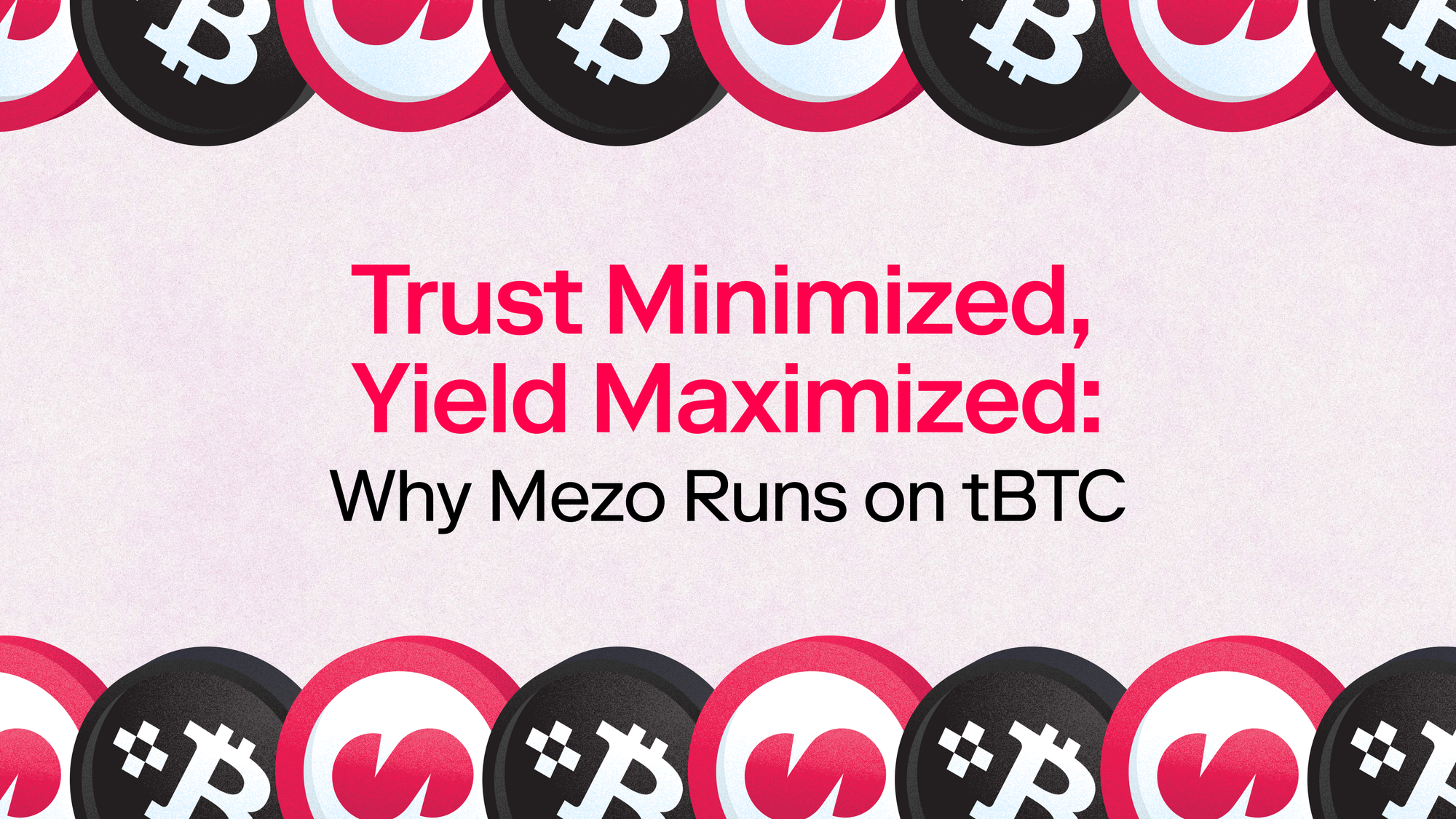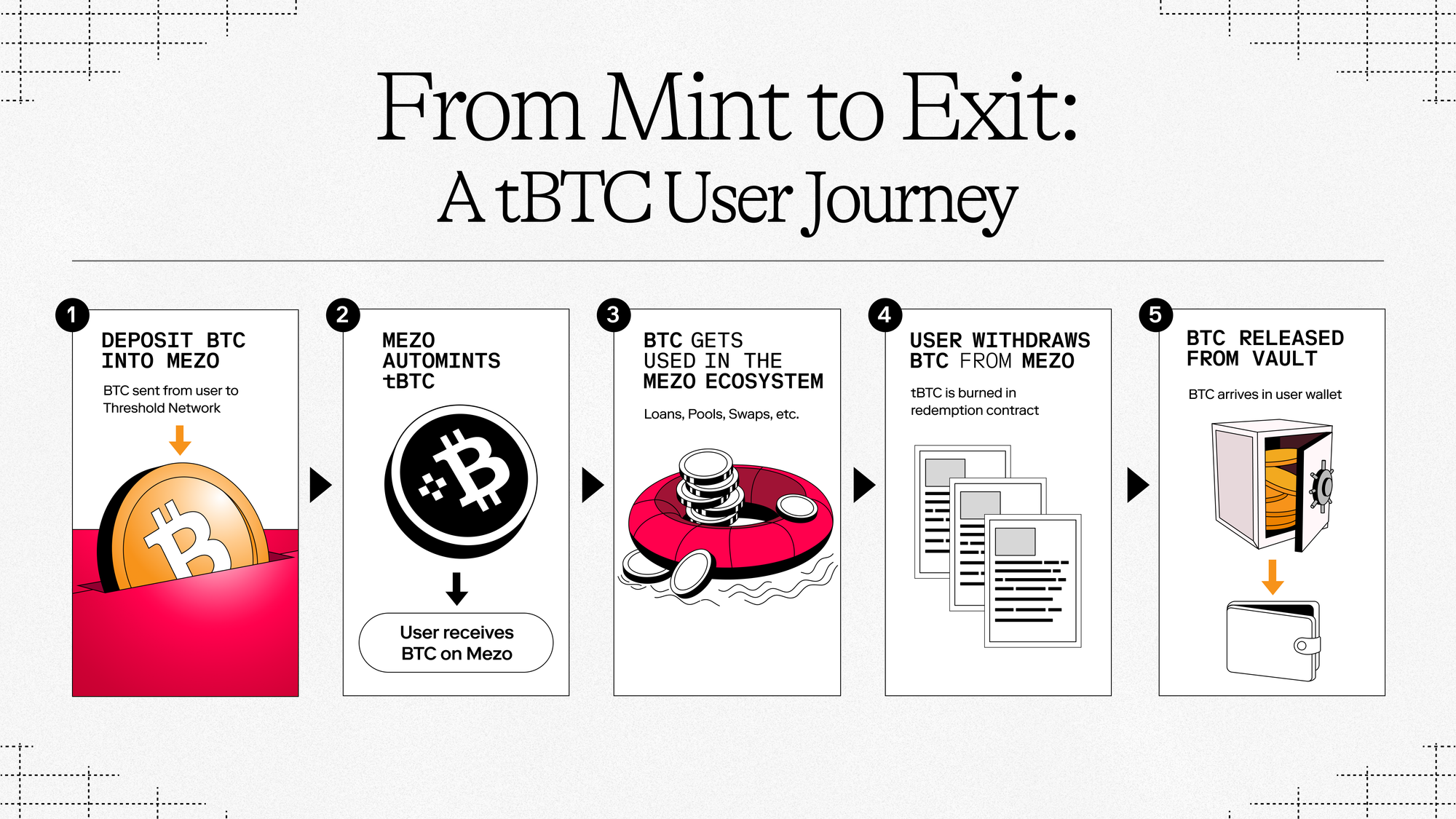Trust Minimized, Yield Maximized: Why Mezo Runs on tBTC
tBTC securely decentralizes over $553M in BTC, eliminating centralized custody risks. Mezo integrates tBTC for Bitcoin holders, enabling productive DeFi use with full self-sovereignty and forward security.

TL;DR:
- Billions in BTC sit idle because centralized custody is a graveyard of broken promises. Over $553 million in BTC sits securely decentralized through tBTC, safeguarding holders from centralized custody risks.
- tBTC is a trust-minimized protocol that lets you mint a 1:1 BTC-backed asset without a centralized custodian.
- Mezo integrates tBTC directly, with no manual effort required from users. This allows you to tap into DeFi yield without surrendering the core principle of self-sovereignty.
Bitcoin's true value lies in the security of its network. But that security has created a paradox. An incredible amount of Bitcoin sits dormant, locked away in wallets. Why? Because every Bitcoin holder knows the cardinal rule: not your keys, not your coins.
The ghosts of Mt. Gox, Celsius, and BlockFi are constant reminders: handing your BTC to a centralized custodian is a gamble you usually lose.
Over 70% of Bitcoin's circulating supply is held by mid- to long-term participants who rarely move their coins. That's hundreds of billions in capital, sidelined from the market, paralyzed by valid fears over custodial risk.
For over 5 years, tBTC has provided a powerful solution to this problem, enabling holders to move their Bitcoin into DeFi ecosystems on Ethereum, Base, and other platforms to earn yield. However, these platforms were not built for Bitcoiners. They treat BTC as just another asset in a multi-chain world, failing to help holders grow their wealth within a native ecosystem.
That compromise is now over. Mezo leverages the battle-tested power of tBTC to create the first true Bitcoin Economic Layer—an ecosystem where using your Bitcoin productively is the primary goal, not an afterthought.
tBTC: A Proven Bitcoin Custody Solution
The history of crypto is littered with the blow-ups of trusted intermediaries. This is a feature of centralization. Any system that relies on a single company, a single multisig, or a single set of operators creates a target.
To succeed where others failed, a Bitcoin custody solution needs to meet three non-negotiable criteria:
- Permissionless Redemption: Anyone, at any time, must be able to redeem their token for native BTC without asking for permission.
- No Single Point of Failure: Control must be distributed so that no single entity or small group can collude to steal funds.
- Onchain Proof-of-Reserve: The 1:1 backing must be publicly verifiable on-chain, 24/7.
Forward security is a critical yet often overlooked feature of this architecture. Because tBTC creates new wallets periodically (e.g., every two weeks), the security of past deposits is insulated from future threats. Even if a malicious actor were to acquire enough stake to influence the selection of new signer sets, they would have no power over the existing wallets holding prior deposits. Each wallet is an independent fortress, locked to the honest signer set that created it. This dynamic, forward-secure approach means that security properties do not degrade over time, distinguishing tBTC markedly from static multisig or federation-based systems.
This is the standard. And tBTC is the only solution that meets it.
Enter tBTC: A Decentralized Bitcoin Bridge, Done Right
Traditional Bitcoin-to-Ethereum bridges require trusting centralized intermediaries—an approach fundamentally misaligned with Bitcoin's sovereign and permissionless ethos. tBTC v2 offers a genuinely decentralized alternative, providing secure and open access to Ethereum DeFi through threshold cryptography. This means tBTC requires a threshold majority agreement from the group of operators before they can perform any action with your Bitcoin. The operator set is rotated weekly, protecting against collusion and fraudulent activity. It’s a system built on an Honest Majority Assumption, where the probability of a wallet comprising a quorum of dishonest operators is mathematically infinitesimal.

How tBTC v2 Works:
- Users deposit native Bitcoin directly into the Threshold Network multisig wallet.
- A randomly selected group of node operators, secured via threshold cryptography, collectively manages these deposits.
- No single operator or small group can control your Bitcoin; an honest majority agreement is mandatory for any action.
- Operators rotate weekly to prevent collusion, ensuring sustained decentralization and security.
The takeaway is simple: with tBTC, you trust math, not hardware or people.
How Mezo Integrates tBTC for Maximum Security
When you deposit BTC into Mezo, you aren't trusting Mezo with custody. You are leveraging the most secure decentralized BTC protocol in existence.
Your BTC is automatically minted and held as tBTC, secured by the same threshold vault that protects the entire tBTC supply. There is no separate custody path. Mezo acts as your on-ramp to this system, allowing you to access BitcoinFi without ever touching a centralized custodian.
While the contract managing your Mezo position is upgradable, its power is limited. It can be updated to add new features or asset types, but it cannot access the underlying BTC.
Battle-Tested and Rapidly Growing
tBTC is a thriving ecosystem that has operated with zero loss events. The Threshold Network secures over 5,243 tBTC—worth over $553 million—is actively secured by the protocol across more than 3,198 holders, and its security and reliability are backed by:
- Independent Audits: Top-tier firms, including Least Authority and CertiK, have vetted the protocol.
- Live Bug Bounties: The Threshold Network runs an active bug bounty program, inviting white-hat hackers to continuously stress-test the code's resilience.
But being battle-tested isn't enough. To ensure tBTC doesn’t just compete, but dominates, the Threshold DAO has endorsed the formation of tLabs, a dedicated development company with the single purpose of accelerating tBTC growth. Led by NuCypher founder MacLane Wilkison, tLabs was formed to address previous development stalls and push a forward-looking vision.
The current tBTC v2 is just the MVP. The roadmap tLabs is executing is designed to make tBTC the undisputed canonical BTC token in DeFi. A key upgrade on this roadmap is the development of the Threshold App-chain, which will move the network’s consensus to its own dedicated chain. This will break the reliance on Ethereum for coordination, reduce fees, and enable native tBTC minting on any chain, creating the ultimate Bitcoin liquidity and settlement layer for all of DeFi.
The fact is, tBTC is Lindy—it has survived and thrived, growing stronger with every market cycle.
Why Threshold Custody is the Bitcoin Standard
The ethos of Bitcoin is rooted in verification, not trust. tBTC resonates with Bitcoiners because it is built on this very principle. With a battle-tested foundation and a visionary roadmap led by tLabs, its position as the leader in decentralized, ERC-compatible Bitcoin is clear.
The financial world is splitting. On one side, you have the opaque, permissioned systems of the past. On the other hand, you have a new world built on transparent, verifiable, and trust-minimized protocols. tBTC is the gateway to that world for every Bitcoin holder.
FAQ – Understanding tBTC Custody
1. What is tBTC in simple terms?
tBTC is a decentralized token on Ethereum that is fully backed 1:1 by native Bitcoin. It allows you to use your BTC in DeFi without trusting a centralized company or intermediary.
2. How is this different from WBTC?
WBTC is controlled by a centralized custodian (BitGo). To get your BTC back, you must ask them for it. tBTC is decentralized; it uses threshold cryptography and a distributed network of operators, allowing you to redeem for native BTC permissionlessly.
3. Who controls the BTC held by the protocol?
A rotating set of independent, financially bonded operators on the Threshold Network. No single entity has control. Any action requires a threshold majority to agree, making the system "human-proof."
4. Is tBTC safe?
tBTC has secured hundreds of millions in assets with zero loss events and has been audited by leading security firms. Furthermore, its future roadmap includes a major security upgrade to a 1-of-N trust model, aiming to make it the most secure bridge in existence.
5. How do I get my native BTC back?
You simply "burn" your tBTC through a redemption contract, and the Threshold Network's operators process the transaction, sending native BTC back to your Bitcoin wallet.
Let's build the circular Bitcoin economy.
Follow @MezoNetwork
🏦 Start borrowing • 📚 Read the docs • 💬 Join Discord • 🛡 View audits
